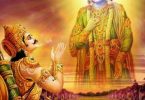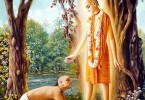Question: We know that Krishna will incarnate as Kalki at the end of Kaliyuga but in the text below it doesn’t mention anything about it. Isn’t Kalki avatar considered as Krishna or Supreme himself? In the purport Srila Prabhupada explains about Chaitanya Mahaprabhu in Kaliyuga but there is no explanation on Kalki avatar, even as assertion of Krishna? Can you please explain the Kalki avatar mystery in Kaliyuga?
Answer by Romapada Swami:
*In SB 7.9.38*
ittham nr-tiryag-rsi-deva-jhasavatarair
lokan vibhavayasi hamsi jagat pratipan
dharmam maha-purusa pasi yuganuvrttam
channah kalau yad abhavas tri-yugo ’tha sa tvam
*Translation by His Divine Grace: *
In this way, my Lord, You appear in various incarnations as a human being, an animal, a great saint, a demigod, a fish or a tortoise, thus maintaining the entire creation in different planetary systems and killing the demoniac principles. According to the age, O my Lord, You protect the principles of religion. In the Age of Kali, however, You do not assert Yourself as the Supreme Personality of Godhead, and therefore You are known as Triyuga, or the Lord who appears in three yugas.*
Lord Kalki is described in Srimad-Bhagavatam 1.3.25:
“Thereafter, at the conjunction of two yugas, the Lord of the creation will take His birth as the Kalki incarnation and become the son of Visnu Yasa. At this time the rulers of the earth will have degenerated into plunderers.”*
Kalki does not come DURING Kali Yuga.
He comes during the juncture of two yugas! The exact sanskrit words used are yuga-sandhyayam – “at the conjunction of the yugas”.
Cc Madhya 6.97-100
Madhya 6.97
TRANSLATION
“Srimad-Bhagavatam and the Mahabharata are the two most important Vedic scriptures, but you have paid no attention to their statements.
Madhya 6.98
“In Srimad-Bhagavatam and the Mahabharata it is stated that the Lord appears directly, but you say that in this age there is no manifestation or incarnation of Lord Visnu.
Madhya 6.99
“In this Age of Kali there is no lila-avatara of the Supreme Personality of Godhead; therefore He is known as Triyuga. That is one of His holy names.”
PURPORT
A lila-avatara is an incarnation of the Lord who performs a variety of activities without making any special endeavor. He always has one pastime after another, all full of transcendental pleasure, and these pastimes are fully controlled by the Supreme Person. The Supreme Person is totally independent of all others in these pastimes. While teaching Sanatana Gosvami… (Cc. Madhya 20.296–298), Sri Caitanya Mahaprabhu pointed out that one cannot count the number of lila-avataras:
lilavatara krsnera na yaya ganana
pradhana kariya kahi dig-darasanaa
“However,” the Lord told Sanatana, “I shall explain the chief lila- avataras.”
matsya, kurma, raghunatha, nrsimha, vamana
varahadi—lekha yanra na yaya ganana
Thus the Lord’s incarnations were enumerated, including Matsya, the fish incarnation; Kurma, the tortoise; Lord Ramacandra; Nrsimha-deva; Vamanadeva; and Varaha, the boar incarnation. Thus there are innumerable lila-avataras, and all of these exhibit wonderful pastimes. Lord Varaha, the boar incarnation, lifted the entire planet earth from the depths of the Garbhodaka Ocean. The tortoise incarnation, Lord Kurrma, became a pivot for the emulsification of the whole sea, and Lord Nrsimha-deva appeared as half-man, half-lion. These are some of the wonderful and uncommon features of lila-avataras.
In his book Laghu-bhagavatamr ta, Srila Rupa Goswami has enumerated the following twenty-five lila vataras: Catuh-sana, Narada, Varaha, Matsya, Yajna, Nara-Narayana, Kapila, Dattatreya,Hayasirsa (Hayagriva), Hamsa, P nigarbha, Rsabha, P thu, Nr simha, Kurma, Dhanvantari, Mohini Vamana, Para urama, Raghavendra, Vyasa, Balarama, Krsna, Buddha and Kalki.
Sri Caitanya Mahaprabhu is not mentioned as a lila-avatara because He is an incarnation in disguise (channa-avatara). In this Age of Kali there are no lila-avataras, but there is an incarnation of the Lord manifested in the body of Sri Caitanya Mahaprabhu. This has been explained in Srimad- Bhagavatam.
Madhya 6.100
Gopinath Acharya continued, “There is certainly an incarnation in every age, and such an incarnation is called the yuga-avatara. But your heart has become so hardened by logic and argument that you cannot consider all these facts.







